Projects
1. Aquaculture & Agriculture Development
2. Environmental & Natural Resources Assessment & Management
3. Environmental Program Evaluation
Partial Client List
- Environmental Sciences and Studies Department
- University System of Maryland, Institute of Marine & Environmental Technology
- Center for Regional Economic Issues, Case Western Reserve University
- Cuyahoga River Restoration
- Earth Day Coalition
- Exxon Valdez Oil Spill Trustee Council
- The Heinz Endowments
- The Hopi Nation Villages of Upper Moenkopi, Hotevilla, and Kykotsmovi, AZ
- Integrated Pest Management Institute of North America
- Maryland Watermens Association
- National Oceanic and Atmospheric Administration
- The Negev Foundation
- Oyster Recovery Partnership
- Pennsylvania Environmental Resources Center
- The Pew Charitable Trusts
- Shorebank Enterprise Group
- Solar Energy, Ltd.
- Town of Southampton, NY
Contact Information
TerrAqua Environmental Science and Policy, LLC
5389 Main Street, Chincoteague Island, VA 23336
United States of America
Telephone: 202-258-9700
Info at terraqua.org
©1996- TerrAqua Environmental Science and Policy, LLC. All rights reserved.
A New Kind of Offshore Marine Fish Cage
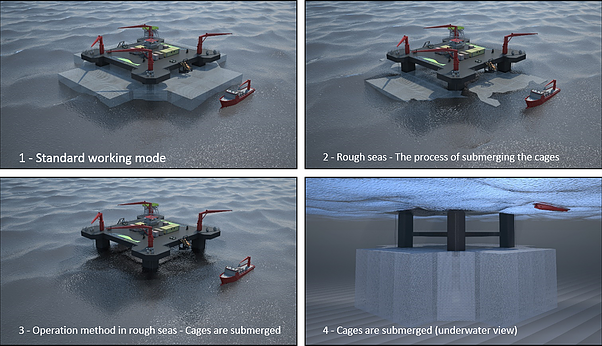
Mariculture systems, an Israeli start-up, developed a new type of offshore platform for raising fish in the open sea. Developed by top Israeli marine industry and mariculture experts, this semisubmersible floating system can withstand virtually any weather condition. Each platform can grow over 4,000 tons of fish in 40 rigid cages at a density of 20 kilos per cubic meter. Because of the design, many kinds of marine fish can be grown sustainably with minimal carbon and other pollutant emissions.
TerrAqua’s role: Provide market studies and commercialization assistance.
Assessing New Technologies for Post-Harvest Treatment of Oysters
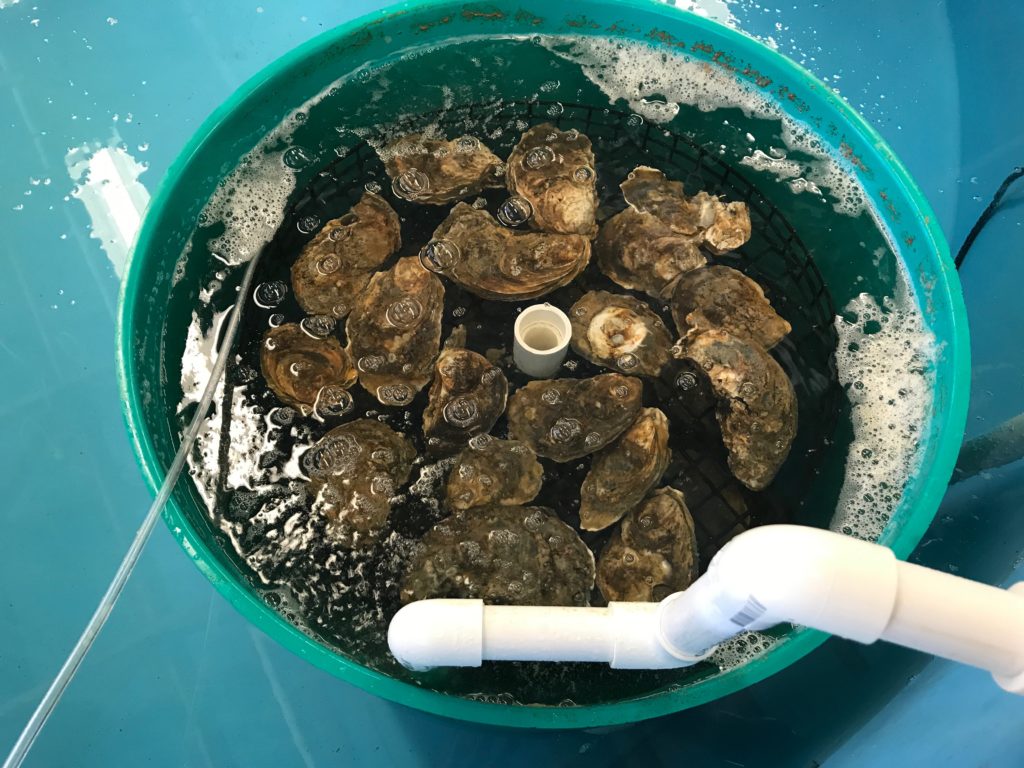
Shellfish aquaculture is America’s largest and fastest-growing marine aquaculture sector. Along with that growth, growers and regulators face more stringent post-harvest treatment requirements to counter the increase in illnesses from the common pathogenic bacteria vibrio during warmer months.
Current post-harvest treatments to remove vibrio change the taste, are unpopular with consumers, or both, and remain prohibitively expensive and largely unavailable to most in an industry dominated by thousands of small, independent farmers. One method that works with coliform bacteria, but not with vibrios, is depuration—holding live bivalves in tanks of clean, flowing seawater where they continuously filter water and naturally expel pathogens from their gills and intestinal tracts. This process is also designed to prevent recontamination.
Better water disinfection may be key as a post-harvest treatment for vibrios.
We began testing two related, proprietary technologies: one, a water purification process, drives insoluble substances to nano-sized dimensions; the other, a photo-catalytic oxidation, can deliver and transport ozone and related biocidal gases into oyster tissues, destroying pathogens with higher efficiencies than any other comparable technology. We are assessing these technologies individually and in combination to create an environment that is lethal to pathogens yet benign to the shellfish being treated.
Both technologies work well in other industrial and aquaculture applications, but had never been tested with filter-feeding shellfish.
In pilot studies funded through Delaware Sea Grant and the manufacturer (Puradigm), we assessed the suitability of using these technologies with live oysters, providing baseline data on oyster survivability. This work may improve consumer safety by reducing vibrio and other pathogen (such as norovirus) levels in live oysters through accessible, inexpensive, non-lethal, post-harvest processing. Such treatments also help to build and diversify the shellfish aquaculture industry, positioning it for new markets.
Partners: Delaware State University, Department of Agriculture and Natural Resources; Ocean Equities, LLC; Virginia Seafood Agricultural Research and Extension Center; Delaware Department of Natural Resources and Environmental Control, Puradigm, LLC
Commercial Culture of Oysters in a Recirculating Aquaculture System
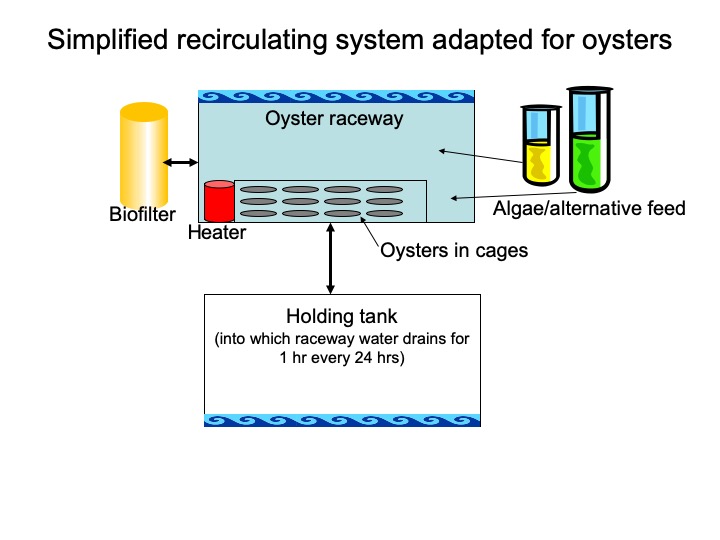
Goal: To develop proprietary land-based aquaculture for high-quality, half-shell oysters and market them with a high margin of return.
Ocean Equities, LLC, TerrAqua and the Department of Marine Biotechnology, University of Maryland Baltimore County are developing a recirculating saltwater aquaculture system for commercial production of Eastern oysters. This approach can have advantages over wild-harvested and conventionally cultured oysters, especially given the high demand and price of high-quality oysters for the half-shell market, coupled with increasing concerns over the safety of consuming raw shellfish.
Earlier research demonstrated that oysters and many other filter-feeding bivalves can be reared in recirculating systems, and that Pacific oysters can be raised economically in them. This is a proof of concept to reduce the technical risk of growing Eastern oysters in COMB’s recirculating aquaculture system.
The major question addressed is whether they can be grown economically relative to other growing methods, using different feeding regimens. This technology can permit biosecure oyster production, assuring product safety for consumers, as well as oysters with a tailored taste and texture. And, because of controlled environmental conditions, they can grow much faster than conventionally cultured oysters.
The U.S. Food and Drug Administration and the Interstate Shellfish Sanitation Conference strongly support applying recirculating technology for safe, biosecure production of raw shellfish. This project was funded by the Maryland Industrial Partnerships (MIPS) program and private investment.
Hopi/Israel/US Agricultural Initiative
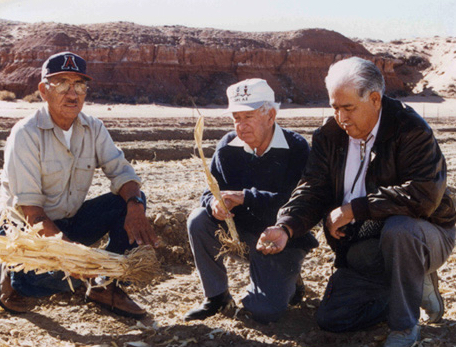
Goal: To develop state-of-the-art capabilities for sustained desert agricultural production and marketing on the Hopi Reservation, and in other arid regions of North America.
Traditional subsistence farming on the Hopi Indian Reservation in northeastern Arizona is no longer economically viable. High unemployment has prompted many young Hopis to leave, further eroding Hopi culture and tradition. Hopi leaders have sought to reinvigorate agriculture on the Reservation, hoping to continue their land traditions, increase economic development and retain their young members.
The Hopi/Israel/US Agricultural Initiative, an example of comprehensive sustainable development in a desert environment, developed environmentally and culturally sensitive commercial agriculture on the Hopi Reservation, and promoted economic development and marketing. Israeli and American agricultural and environmental experts and Hopi leaders, utilizing Israeli desert agricultural methods, developed his Initiative. Building on a long farming tradition, the Initiative sought to (1) improve the Hopi’s capacity to practice modern desert agriculture with previously unutilized and underutilized water sources; and (2) develop Hopi economic self-sufficiency through profitable farming, consistent with Hopi culture. The first small-scale demonstration farm began in May 1998.
Despite problems with equipment and resource allocations, farmer interest, and early freezes, participants harvested melons, squash and tomatoes. These were given to villagers, sold at local markets and picked by school groups. Participants gained new desert agriculture techniques, the ability to grow new crops, and market access.
Clients: The Negev Foundation, the Hopi Indian villages of Upper Moenkopi and Hotevilla, AZ. This project received additional funding from USDA’s Fund for Rural America and the Seventh Generation Fund.
TerrAqua’s role: Help develop, manage and expand the project; acquire funding.
Improved Water Sampling for Shellfish Pathogens
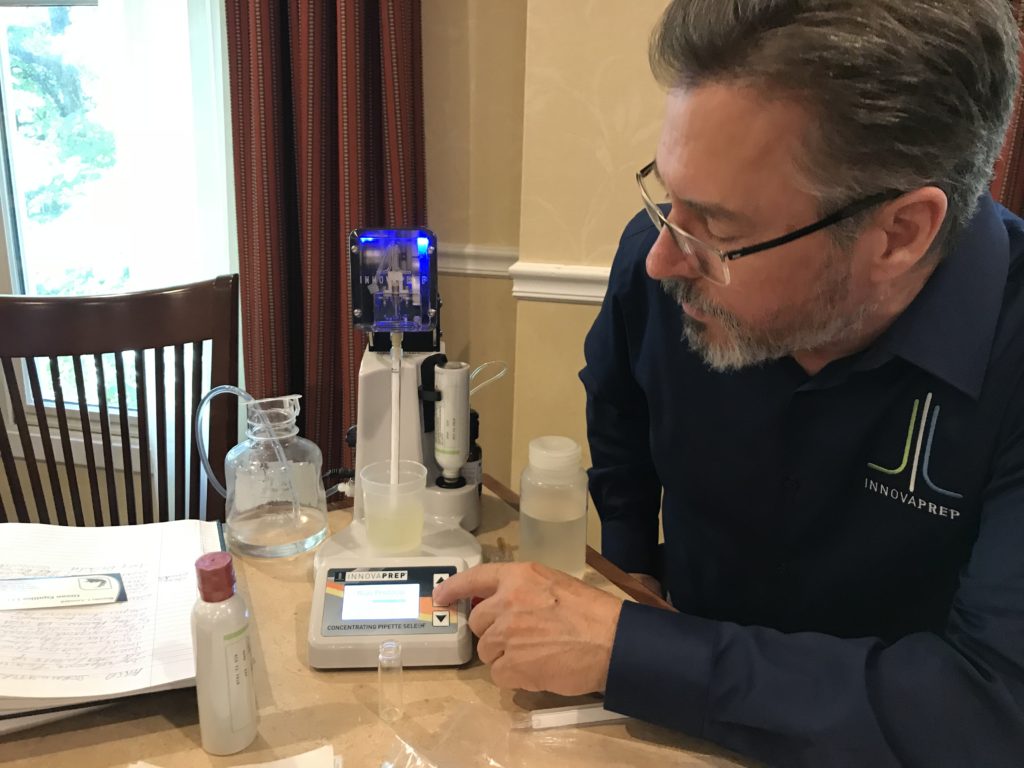
InnovaPrep, a Drexel, Missouri-based microbiological tech company, received federal funding to develop a first-generation system for onsite processing of large volumes of shellfish-growing waters, to prepare them for Quantitative Polymerase Chain Reaction (qPCR), which could be analysed onsite or easily sent elsewhere. The goal is to allow real-time sea water monitoring for vibrios and, eventually, other human pathogens that can accumulate in shellfish, using small, highly concentrated water samples.
TerrAqua’s role: Helping to ensure that the process while it’s being designed can best help the shellfish industry and the labs that support it.
Improving Mideast/Midwest Agriculture Ties
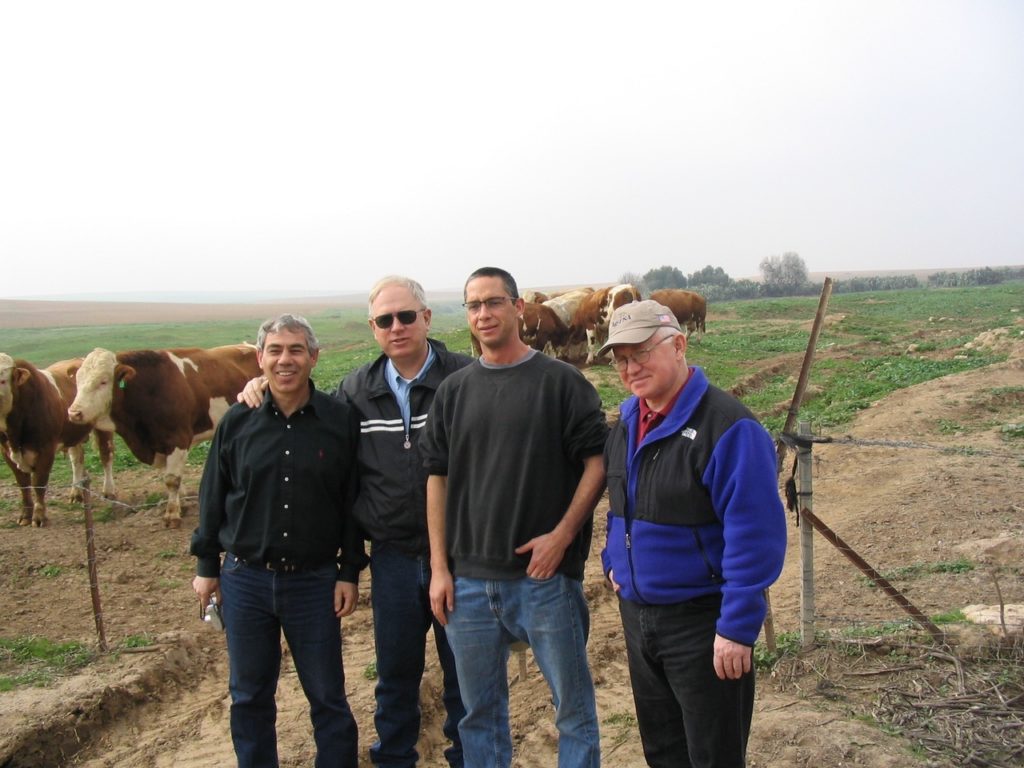
In an effort to improve agricultural ties—R & D, technology and agricultural biotech transfer, scientific and marketing exchange—between Ohio and Israel, TerrAqua and the Negev Foundation developed a preliminary overview to help Israeli and Ohio entities and growers better understand the abilities and needs of each, and opportunities for increasing future cooperation.
With that in hand, the Foundation has begun working with government and academic entities and individuals in both regions. Several trade missions and R&D exchanges have taken place, and concrete projects are being developed as a result: exports of Ohio-bred beef calves to Israel, bio-security technology, drip irrigation improvement and others.
Solbar, an Israeli company that is the world’s leading processor of soy protein concentrates and isolates, and soy isoflavones, will be building a new plant, its first outside Israel, in central Ohio.
The Negev Foundation, the Government of Israel, the Ohio Department of Agriculture, USDA and other organizations have supported this project to date.
Integrated Aquaculture and Agriculture Development
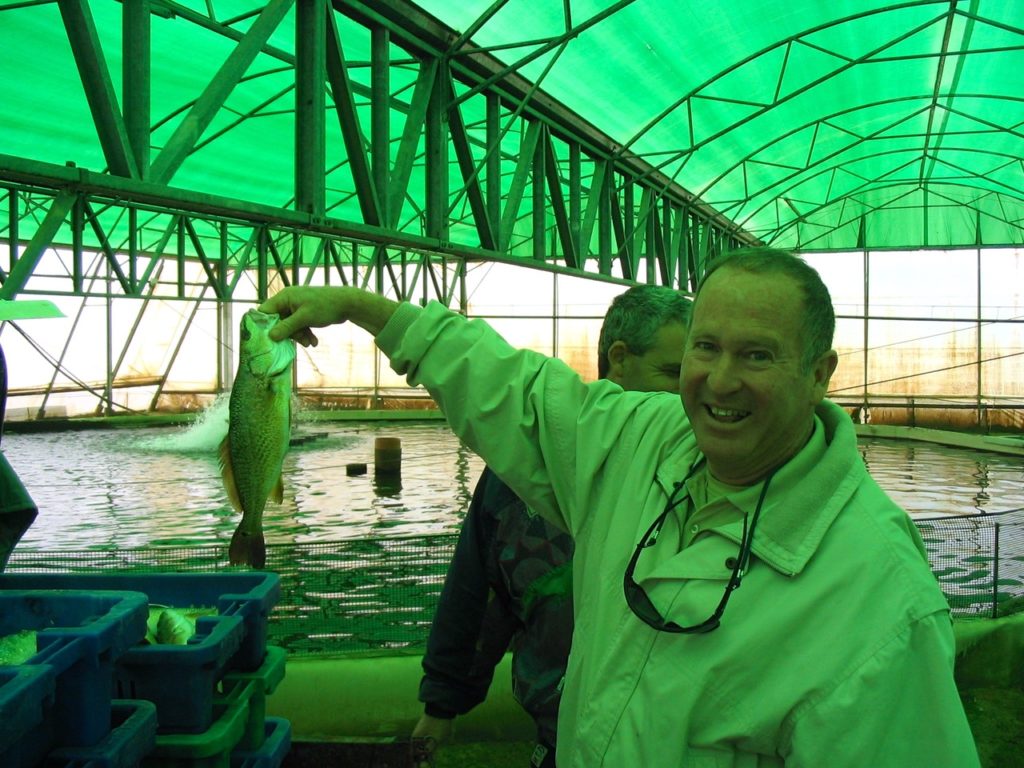
Goal: To evaluate the potential for integrated desert aquaculture and agriculture on several southwestern U.S. sites.
In integrated aquaculture and agriculture, aquaculture effluent is recycled to irrigate greenhouse or field crops. Irrigating crops with aquaculture effluent conserves water, fertilizer and other resources, and lowers production costs.
Israeli researchers and growers have developed commercial integrated intensive aquaculture and agriculture in the Negev Desert. Using this approach, we characterized site suitability and options for integrated aquaculture/agriculture development on several Southwest sites. We evaluated local environmental conditions, including water quantity and quality, soil composition, topography and climate. Our study covered the technical and marketing potential, and determined what additional, site-specific information is needed.
Next steps, should the client decide to pursue it, include (1) an in-depth feasibility and engineering study and a detailed economic and market study to determine actual crop and product choices on specific sites, and (2) an income-generating pilot project, to test and adapt a number of established Israeli techniques and approaches to local conditions.
Such a project could benefit the surrounding communities in many ways, providing employment, new skills development and educational benefits.
Client: A private corporation and The Negev Foundation, in conjunction with the Ramat Negev Desert Agro-Research Center.
Oyster Farming Assistance for Patuxent River, MD Growers
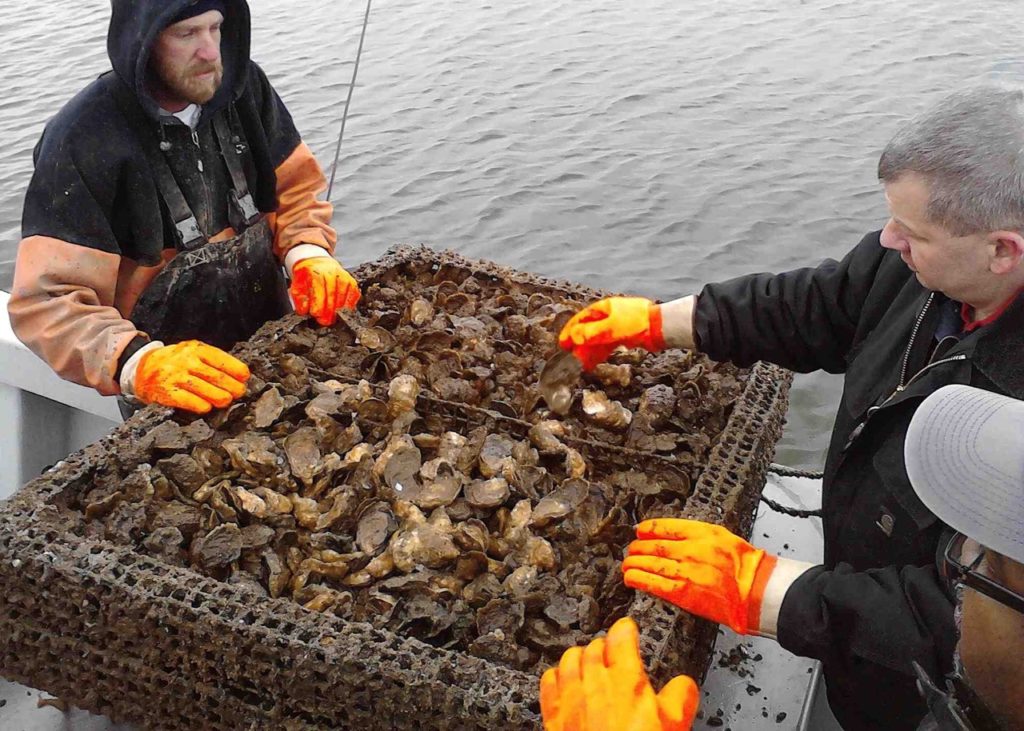
Several years ago, Calvert County Watermen’s Association members began receiving technical support from Morgan State University’s Estuarine Research Center and other entities to farm oysters in the Patuxent River, a Chesapeake tributary. These Maryland watermen and others are interested in growing oysters in Chesapeake Bay to help restore the formerly abundant resource, currently at one percent of its historic level. In December 2010, CCWA members harvested their first farmed oysters. Other growers are interested in developing cage culture. Once these efforts were underway and expanding, TerrAqua and Ocean Equities provided marketing assistance. Our first step evaluated how and to what extent the growers can successfully raise and market oysters—the costs, the potential income and the regional market potential of different growing and marketing options—in a tailored, easy-to-understand guide. (For a copy of the executive summary, click here.) Our second step, additional funding permitting, will be to take growers to other commercial growing operations, and provide growers market access beyond their current networks. Funded by grants from the Maryland Technology Development Corporation (TEDCO) and the Southern Maryland Agricultural Development Commission, with in-kind assistance from the Maryland Department of Natural Resources and Maryland Sea Grant.
Oyster Farming for Chesapeake Watermen
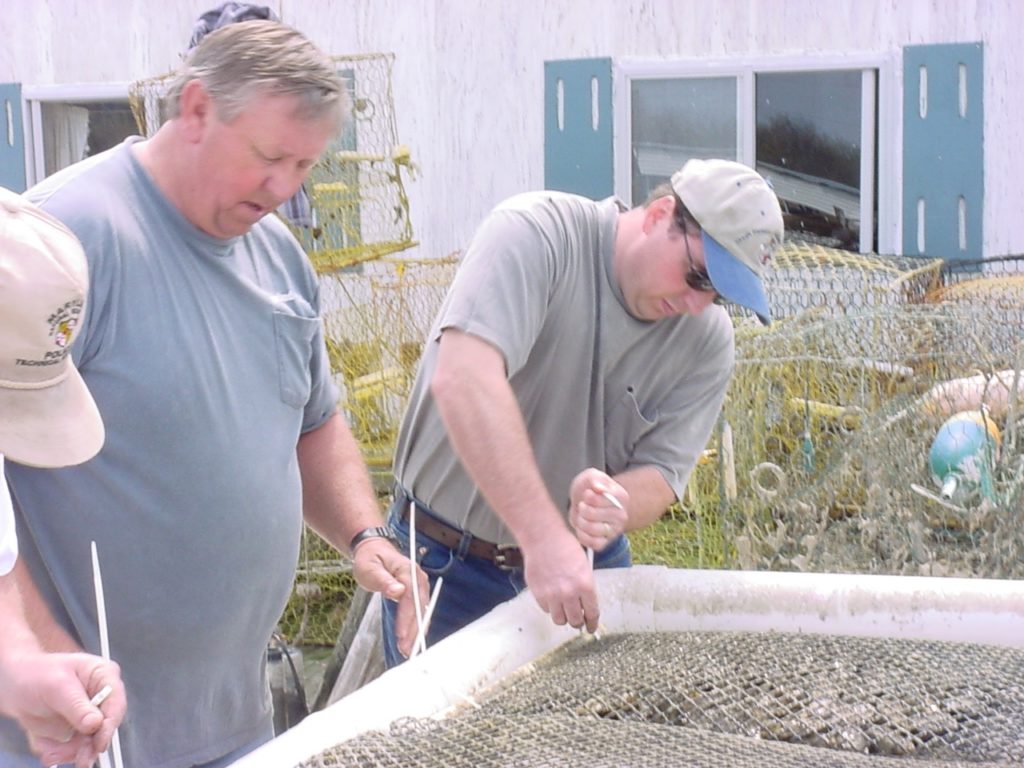
Goal: To help local watermen communities develop sustainable, small-scale oyster farming and, in a small way, restore oysters to Chesapeake Bay.
The roughly 1,200 inhabitants of Smith Island, MD and Tangier Island, VA are the direct descendants of British colonists who first settled these isolated Chesapeake Bay islands in the mid 1600s. The islands’ economies have long depended on crab and oyster harvesting. Recent declines in oyster resources threaten the watermen’s livelihood and their children’s future on the islands.
To offer an additional economic option compatible with the islands’ unique traditions, we designed a project, modeled after successful French and Irish approaches, that develops an integrated oyster industry, capable of producing, processing and marketing oysters almost year-round. We conducted oyster-farming workshops on both islands in July 1998, and began a pilot oyster culture project for Smith Island watermen in spring 1999.
We developed a marketing business plan for the watermen (for a copy, click here), and provided access to Washington, DC-area restaurants, seafood retail markets and wholesalers. In so doing, we demonstrated the marketability of Smith Island oysters, selling some oysters to a number of establishments, and eliciting the interest of many more.
The watermen’s story can be an effective marketing tool that, combined with direct sales, can increase revenues going directly to them.
The watermen received ongoing technical and marketing advice. Although as a commercial operation the project stopped because of state-imposed shellfish harvesting closures and related issues, some watermen have continued to grow oysters. Future project success will ultimately depend on the number of watermen involved, their success in raising and marketing oysters and their ability to make the industry economically self-sustaining.
Client: A consortium of state and federal agencies, universities, nonprofits, extension services and watermen. Funded by grants from the Chesapeake Bay Trust, the Keith Campbell Foundation for the Environment, the Community Foundation of the Eastern Shore and the National Oceanic and Atmospheric Administration Office of Sustainable Development.
TerrAqua’s role: Help develop and manage the project, and acquire funding.
Sustainable Small-Scale Commercial Aquaculture in Coastal Communities
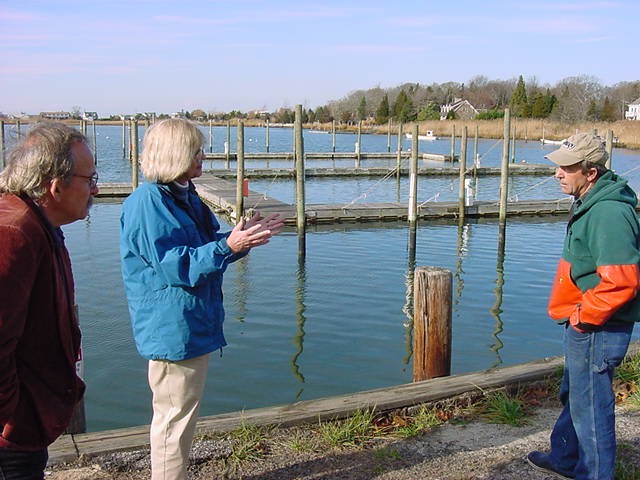
In many coastal communities, commercial fishermen, no longer able to obtain a livable income from shellfish harvesting, have had to find other sources of income. These traditional fishermen and their trade are key components in the ambience of coastal communities. Without them, seaside towns lose much of their identity. Wild shellfish stocks have declined in many areas, and coastal lands have become expensive.
Small-scale shellfish aquaculture may provide marine-based livelihoods for displaced fishermen, preserving a lifestyle crucial to maintaining the integrity of these communities. Aquaculture can also reduce fishing pressure on and enhance wild shellfish stocks.
This project evaluated potential environmental, regulatory, policy, economic and productivity issues associated with small-scale commercial aquaculture in Southampton, NY. It included a market assessment, developing cost-of-production models and surveying various stakeholder groups to determine attitudes, concerns and potential sticking points. (For a copy of the executive summary, click here.)
One recommendation was to create aquaculture “management areas” for transient (mobile) culture gear. One set of zones, for nursery rearing, would be in calmer, approved or conditionally closed (to shellfish harvesting) areas to avoid boat traffic. A second set of zones, for grow-out, would allow growers to move gear from shallow areas in summer to deeper water in the winter, to avoid ice. Another recommendation was to place operations in some fish trap areas, already designated for baymen use and protected from boat traffic.
The final results provide a roadmap for decision-making, addressing how to decide whether to proceed with small-scale aquaculture, and what constitutes acceptable, sustainable growth of the industry. The study has application for other coastal communities also contemplating small-scale aquaculture development, but concerned about adverse impacts, liability and the likelihood of success. Sustainable shellfish culture can flourish in communities where broad support exists among residents who, despite differing agendas, can agree on the benefits.
The Integrated Pest Management Institute of North America
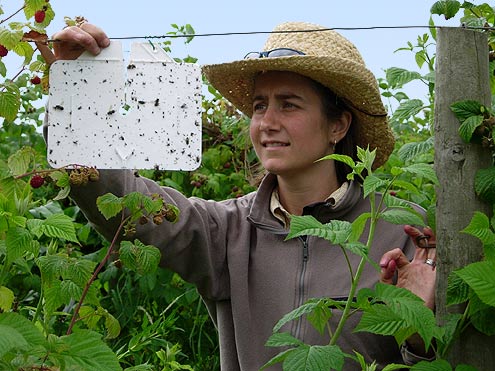
Goal: To broaden the adoption of IPM practices nationwide, thereby reducing pesticide risks and promoting a healthy environment.
Integrated pest management (IPM) benefits the environment by preserving natural enemies of pests, delaying pesticide resistance and reducing ecological and human health risks by reducing pesticide use. Despite such benefits, IPM adoption in the US has been far below potential. One reason is the failure of the marketplace to demand IPM-produced goods from producers.
Recently, several regional programs have increased IPM adoption locally by identifying products as certified as IPM-grown, and by raising consumer awareness.
The IPM Institute plans to increase IPM adoption nationwide through a new mechanism that will (1) certify food products with a single, credible, national IPM mark that will be regularly updated; (2) coordinate development of rigorous, science-based IPM production criteria for each region with land grant university IPM specialists, extension agents, grower groups and others; (3) audit operations for compliance; (4) educate consumers; and (5) provide technical assistance to growers, food processors, wholesalers and retailers.
The IPM Institute plans to work closely with existing programs and interests (e.g., Cornell University’s licensed IPM label program; the Institute for Agriculture and Trade Policy; World Wildlife Fund; American Farmland Trust; Massachusetts Extension Partners with Nature; Mothers and Others; The Food Alliance) to reduce the confusion of competing, regional labels.
Client: The Integrated Pest Management Institute of North America
TerrAqua’s role: Help develop the program and its funding.
Urban Aquaculture of Marine Fishes
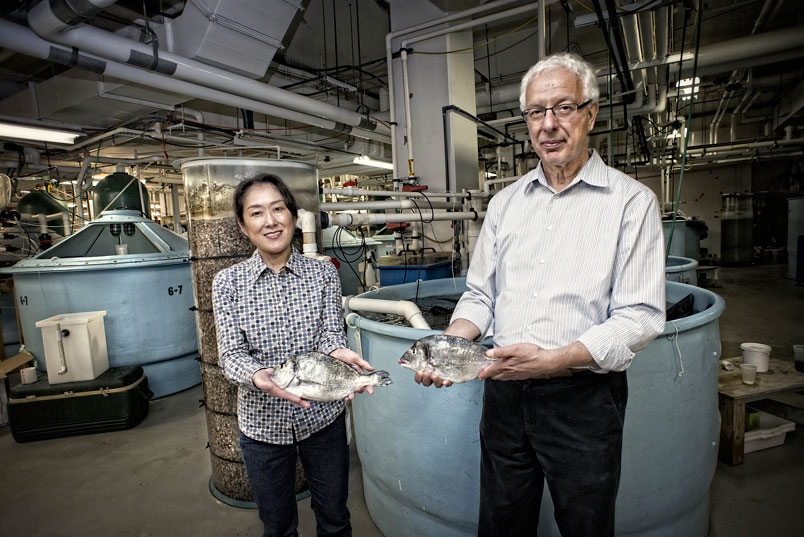
Indoor fish farming in closed recirculating systems offers many advantages to conventional outdoor ponds, raceways, and floating net pens. They are non-polluting, pose fewer user conflicts in nearshore areas and, because they use artificial sea water, can be located almost anywhere, including in warehouses in economically disadvantaged inner-city areas. Additionally, these operations can provide fresh fish to markets the day fish are harvested.
Researchers at the Department of Marine Biotechnology, University System of Maryland, patented a method for growing orata, or gilthead sea bream (Sparus aurata), a Mediterranean fish—the first time a marine fish of such high value had been reared in a completely closed indoor system. This research breakthrough provides solutions to many of marine aquaculture’s current shortfalls. With no impact on the environment, it is ecologically sustainable, and it produces clean and healthy fish that are not exposed to environmental pollutants or pathogens.
In addition, it creates many potential commercial advantages, such as much faster growth, and being able to provide fish to markets the day of harvest.
These systems have the flexibility, like a greenhouse, to grow other high-value species such as European sea bass (branzini) and Atlantic salmon in response to market demand and ongoing research.
University researchers are also developing a scalable and marketable technology to convert fish waste from these systems into methane gas by microbial degradation. This treatment allows the system to support high-density, bio-secure aquaculture with virtually no water exchange, which conserves water, eliminates effluents or escapees and ensures no interaction with the environment. The methane can be an energy source for aquaculture facilities or sold to electric companies.
Clients: Department of Marine Biotechnology, University of Maryland Baltimore County, the Abell Foundation and Maryland Sustainable Mariculture, LLC and Maryland Technology Development Corporation (TEDCO).
TerrAqua’s role: Help commercialize these technologies. Study the marketing potential and develop a business plans.
Appalachian Forest Assessment
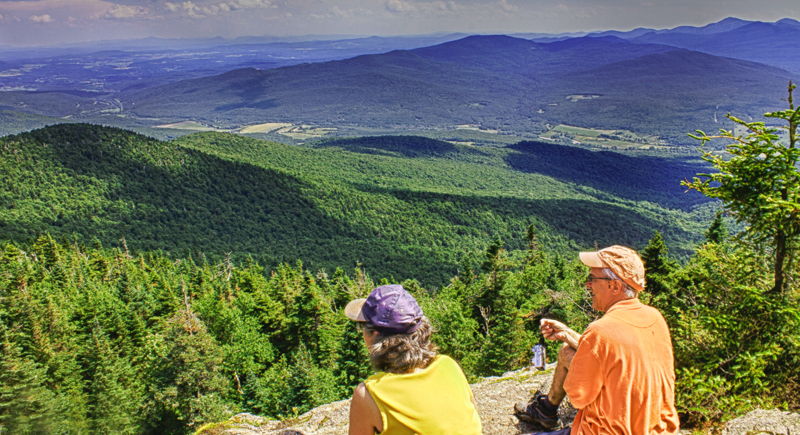
Goal: To assess the needs for a new Appalachian forest protection project, and opportunities for joint grantmaking throughout the region.
TerrAqua reviewed the environmental and demographic characteristics of the northern Appalachian region, and governmental, NGO and other private sector activities. Drawing from existing studies, we characterized the ecological base, ecological health, sources and causes of environmental degradation, resource use, historical and present dependence on and relation to the Appalachian forest ecosystems, and organizations active in forest protection and management. We also characterized potential funding initiatives and partners.
We determined (1) what additional technical information would help parties collaborate better to protect the regional environment; (2) target audiences for education, including federal, state and local governments, corporate and individual landowners, nonprofits; (3) which organizations can increase their capability to promote natural resource conservation and sustainable development in Appalachia; and (4) ways to strengthen the regional economy while protecting the environment.
Client: The Heinz Endowments
Evaluating Stream Stewardship Activities in the Cuyahoga River Watershed
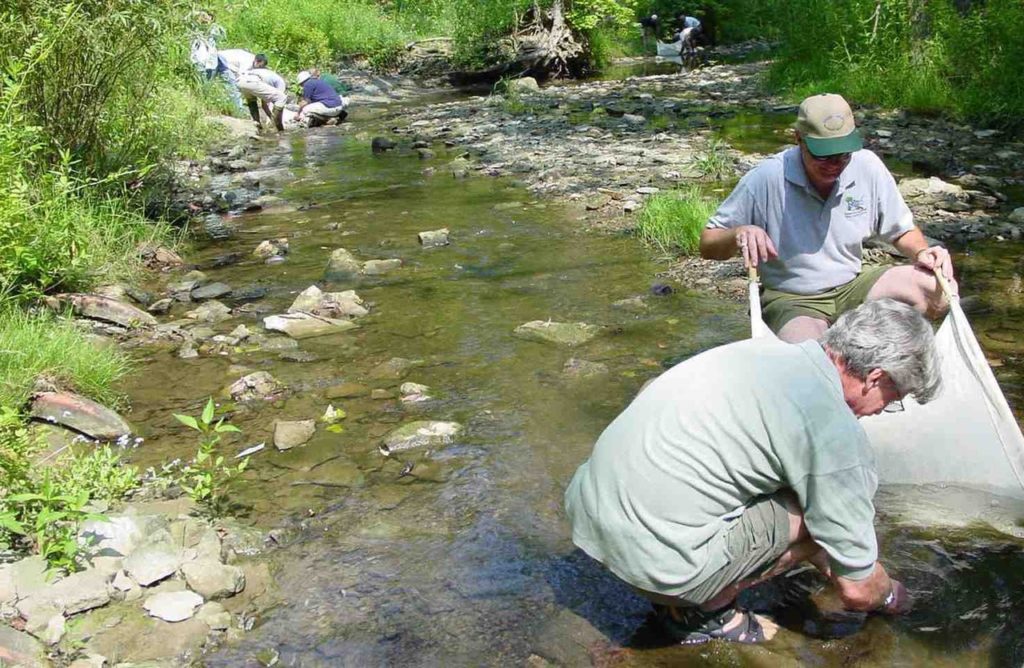
The Cuyahoga River Community Planning Organization (CRCPO), in an effort to reduce nonpoint source pollution entering the Cuyahoga River watershed, began Stream Stewardship Programs in two tributaries, Big Creek and Yellow Creek. These programs were implemented under the Cuyahoga Remedial Action Plan. Program managers hope to build self-sustaining, community-based stewardship throughout the entire watershed.
TerrAqua evaluated the effectiveness of both stream stewardship programs, measuring their effectiveness in raising citizens’ awareness of watershed issues, fostering their participation in stewardship, improving their ability to reduce water quality impediments, and restoring their local watershed environments.
We analyzed which program elements are most effective, and under which circumstances, and the extent to which there is measurable environmental change—e.g., lowered concentrations of pollutants, more riparian zones, acres restored.
We also assessed the ability of each community to sustain its own stewardship program, which will help the CRCPO transfer this responsibility to local citizens. We provided recommendations on how the programs can move toward organizational and programmatic independence, and how long-term stewardship goals can be measurable, implementable and compelling.
Client: Cuyahoga River Restoration
Evaluation of Allegheny College’s Center for Economic and Environmental Development Program (CEED)
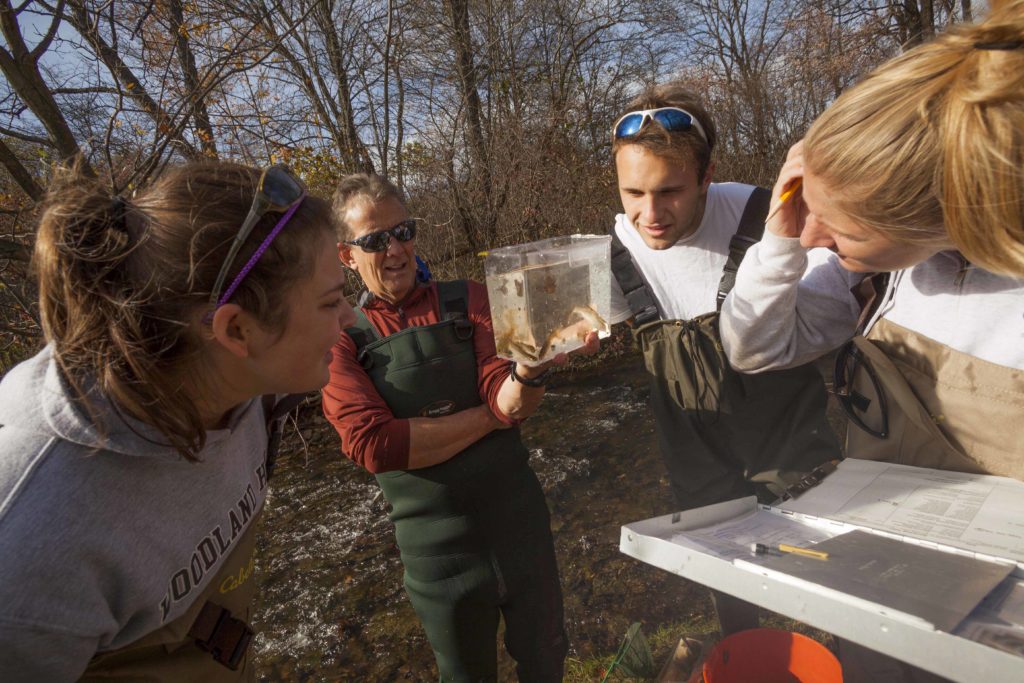
CEED, founded in 1996 as project of Environmental Sciences and Studies Department, has a two-fold mission: (1) to expand educational opportunities to Allegheny College students, and (2) to increase community and regional leaders’ understanding of how economic and environmental decisions can work hand-in-hand to revitalize northwest Pennsylvania.
CEED absorbed an existing project (French Creek Environmental Education Project) and initiated others, including: Environmental Curriculum Project; Strategic Environmental Management; Ecotourism; Art and Environment; Meadville Community Energy Project; Sustainable Forestry and Agriculture; French Creek Visioning Project; and Enterprise for Sustainability Program.
CEED is managed by an Environmental Science associate professor and an administrator; Environmental Science/Studies faculty or faculty from other departments manage individual projects. CEED wanted to know how it could become a sustainable organization given the small number of faculty members, their limited time, and a regular student turnover.
TerrAqua and Colby College professor David Firmage conducted an evaluation through on-site interviews at Allegheny College and in the larger community of Meadville. We developed recommendations for (1) organizational development, (2) working with faculty and community members, (3) an external advisory committee, (3) ensuring project continuity, (4) community liaison, (5) CEED’s relationship to the rest of Allegheny College, (6) faculty evaluation, (7) ensuring academic quality for students, (8) developing a strategic implementation plan, and (9) broadening CEED’s base of support.
Evaluation of the Pew Charitable Trusts’ Sustainable Forestry Project
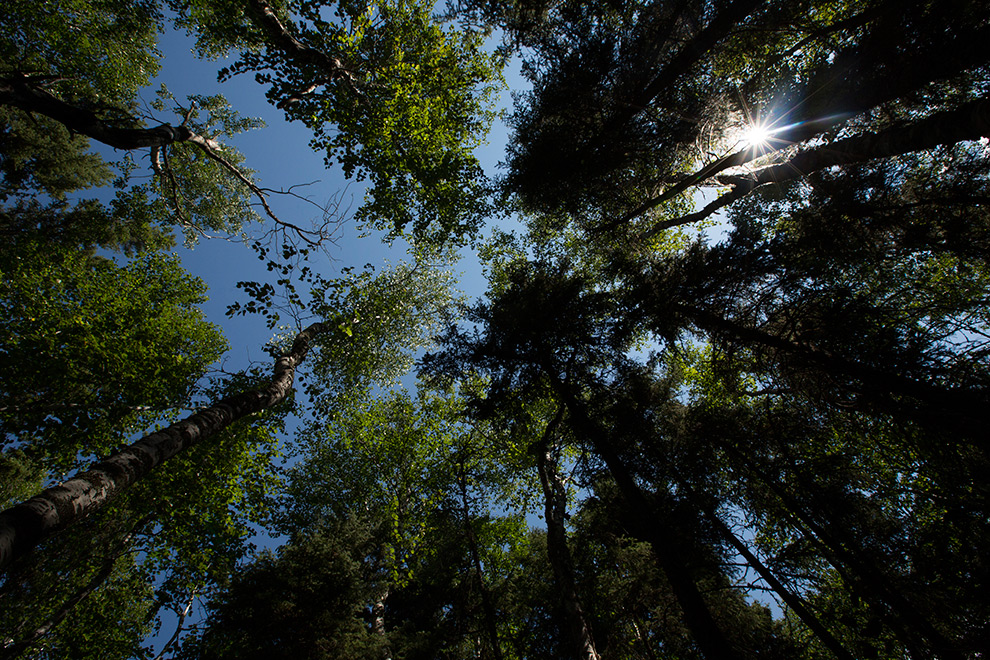
There is broad public concern with forest management and timber harvesting practices. The idea of certifying forest products produced in an environmentally and socially sensitive manner grew out of concerns with practices in the tropics.
The Pew Charitable Trusts, to encourage market-driven changes in U.S. forest practices, has funded several NGOs to certify wood products from forests with environmentally sensitive timber management and harvesting standards, and to develop a network of progressive foresters committed to practices that protect the diverse ecological values of both public and private forests.
Market-driven certification is relatively new for U.S. forest products, which encompass solid-wood products (lumber, plywood and particle-based panels), pulp and paper. Our evaluation included (1) how well the project encouraged adoption of sustainable forest management practices; (2) how effectively Pew’s grantees implemented this strategy; (3) possible alternative strategies; and (4) the marketing campaign’s role and effectiveness. We assessed what each added to the existing array of laws, regulations, accepted practices, and development of market forces.
Client: The Pew Charitable Trusts
TerrAqua’s role: Evaluation team member.
A Green Building for Downtown Cleveland
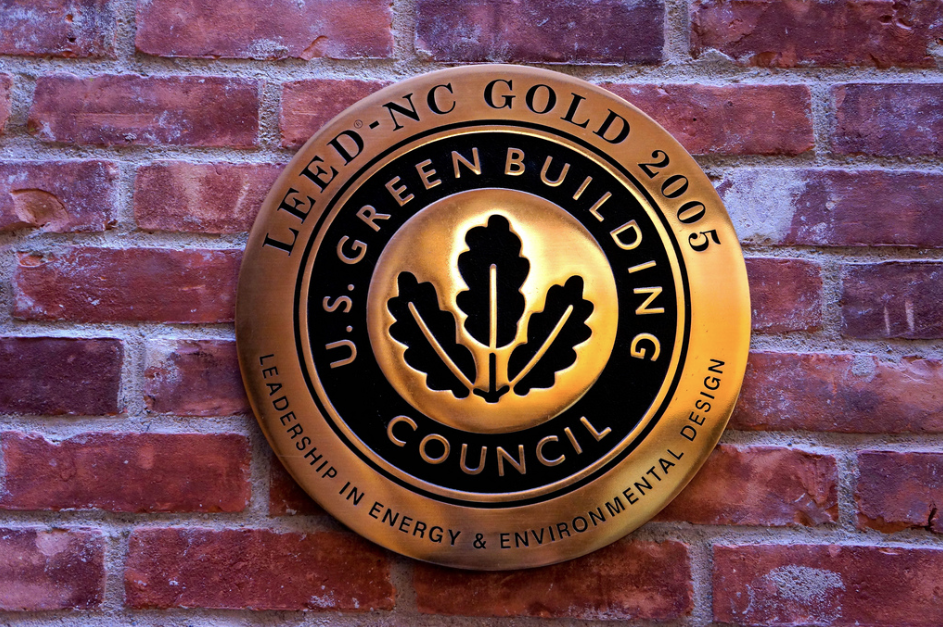
Goal: To evaluate the current state of green buildings in the US, and to plan a shared green office building for nonprofit organizations in Cleveland.
Green or “smart” buildings are designed, renovated or constructed, and operated with environmental and energy efficiency, and to be healthy for their occupants. We documented and evaluated a number of representative green buildings around the country (especially those that house nonprofits), to determine their locations, their “greenness,” how they are managed, their tenants, the cost to construct or retrofit, how they are capitalized, how well they function, and which approaches have been most successful.
We surveyed existing and planned green buildings through literature reviews, site visits and discussions with building owners, tenants, builders, developers, architects, academics and others. (For a copy of the report, click here.) Then we conducted a needs assessment to identify and document potential nonprofit occupants, their needs, their financial ability to participate, and how they envision the building. Lastly, we conducted a feasibility study, in conjunction with Cleveland Neighborhood Progress, to select a site and facilitate the building’s financing and development.
We worked with local nonprofits to identify what they want, need and can afford, and to determine building options, financing options (e.g., program-related investments, historical credits, low-interest financing in empowerment zones, brownfields reuse options) and renovation costs.
This project was an opportunity for environmental and economic development interests in Cleveland to work together on a project that benefits the community in many ways.
Client: The Earth Day Coalition and Cleveland Neighborhood Progress, through George Gund Foundation grants.
TerrAqua’s role: Develop the grant proposals; conduct the studies.
Electric Utility Restrucuring in Pennsylvania: Environmental and Consumer Effects

Goal: To influence the implementation of Pennsylvania’s 1996 law for restructuring the state’s electric utility industry to protect consumers and the environment.
The Heinz Endowments invested in a partnership aimed at giving environmental advocates an effective voice in the debate about electric utility restructuring in Pennsylvania. In 1996, the state legislature passed the Electricity Generation Customer Choice and Competition Act which fundamentally altered an industry that produces about 40% of the state’s air pollution.
Nearly two-thirds of Pennsylvania’s electricity has come from cheap and outdated coal-fired plants, the rest from nuclear power, with large cost overruns that were passed on to consumers. Since the law will encourage consumers to purchase electricity from the cheapest generating plants, without regard to pollution and other externalities, its environmental impacts could be quite negative.
Since many details of the new regulatory regime not yet defined, the Heinz Endowments assembled a group of grantees to develop a proactive approach (public education, litigation and regulatory intervention, market development of cleaner energy generation) to steer utility restructuring toward environmental and consumer protection.
The new deregulated marketplace is emerging with programs for cleaner energy and better consumer and environmental protections. One result of grantees’ intervention: electricity customers’ share of the utilities’ bad investments has dropped, as have rates.
Additionally, energy efficiency services have been increased to meet the needs of more low-and moderate-income families. A Sustainable Energy Development fund has been created that will assure growth of this industry and increase the availability of clean energy. The combined effort has saved Pennsylvania’s residential electricity customers over $7 billion in 18 months.
Client: The Heinz Endowments and Pennsylvania Resources Council, Inc..
TerrAqua’s role: Organize diverse nonprofit organizations to form the Pennsylvania Campaign for Clean, Affordable Energy; facilitate their dialogue and meetings.
Environmental Costs of Urban Sprawl
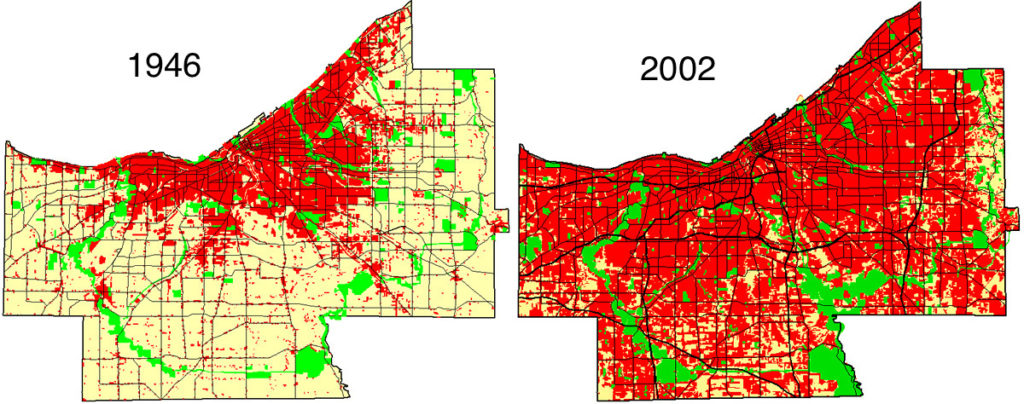
Several decades ago, following the dramatic loss of about one-fifth of Northeast Ohio’s manufacturing jobs, Cleveland turned to the academic community for help in analyzing the region’s economic problems. Case Western Reserve University’s Center for Regional Economic Issues (REI) was created to help economic recovery. REI seeks to improve the economic welfare of the nation’s regions through a unique program of policy research, education, and decision support. REI’s studies have contributed to the region’s economic development by providing better information to policy makers.
This capability gave Cleveland an information advantage, changing its thinking about itself and helping to launch some of the City’s most important programs during the 1980s.
REI is now developing models for “A Consensus-Based Framework for Economic Analysis of Alternative Land Use Patterns in Northeast Ohio.”
TerrAqua helped develop a cost-of-sprawl methodology. We identified and quantified the environmental costs of urban sprawl on air, land and water, and studied successful land-use models in other regions for their applicability in Northeast Ohio. We also (1) attended stakeholder meetings to determine regional needs and abilities, (2) developed a framework for economic analysis of land-use development alternatives, (3) helped develop recommendations and alternative analytical methods, and (4) helped present technical information and findings clearly to all regional stakeholders.
Client: Center for Regional Economic Issues, Case Western Reserve University
Fisheries, Habitat & Pollution Conference Series
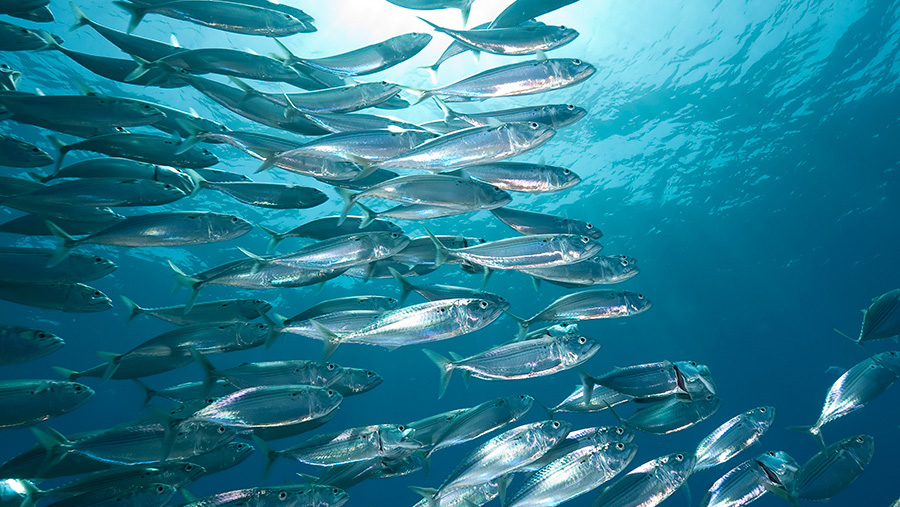
Goal:To explore how marine pollution and environmental degradation affects fisheries and ecosystems, and its significance to environmental managers.
Pollution and habitat studies have been poorly linked to fish population studies or, by extension, to resource management. Interest is growing, inside and outside of government, in developing such linkages so that the environment can be managed as an ecological whole rather than as collection of separate problems and processes.
Obstacles to identifying these relationships include (1) insufficient data, (2) insufficient use of existing data, (3) lack of analytical tools, (4) few direct examples of pollution effects, and (5) institutional constraints. More information is needed on the comparative effects of pollution and other anthropogenic and natural factors, on ecological thresholds, and on pollution’s direct and indirect effects.
Management’s needs, in addition to good science, include better prediction, better ability to manage the environment at different organizational levels (e.g., individual populations, species assemblages, ecosystems), better communication and coordination among and within agencies, and, above all, more awareness of the issue within the scientific community at large.
This has been the focus of the conference series, begun in 1995, and held in Baltimore, MD, Bodega Bay, CA and Charleston, SC. An important additional priority has been how scientific results may improve resource management and be communicated effectively. The 1997 conference was the first one to be held after Congress passed the Sustainable Fisheries Act (SFA) in 1996.
The Essential Fish Habitat component of this legislation requires the National Marine Fisheries Service (NMFS) to identify and conserve the habitat considered essential to support stocks of all federally managed fish species. The SFA embodies a conceptual shift from fisheries management to ecosystem management, and as such represents a major departure from past management policies and philosophies.
For at least three decades, it has been increasingly obvious that marine habitats in the United States and elsewhere are being altered and contaminated, that overfishing is widespread, and that fishery populations are in broad decline. The SFA was born of a scientific paradigm shift in fisheries: a recognition that abundance of individual fish species cannot be fully understood outside of their ecosystem contexts, particularly their physical habitats. In turn, the SFA legislated an institutional paradigm shift that will make fishery management much more complex but, it is hoped, also more effective.
Selected papers from each conference were published in three peer-reviewed journals: Transactions of the American Fisheries Society (1995 conference), North American Journal of Fisheries Management (1996 conference) and Ecological Applications (1997 conference).
Client: A consortium of national and regional agencies, including the National Oceanic & Atmospheric Administration, the Atlantic States Marine Fisheries Commission, et al.
TerrAqua’s role: Develop the concept, plan and organize the series, acquire funding.
Jellyfish Predation in Prince William Sound
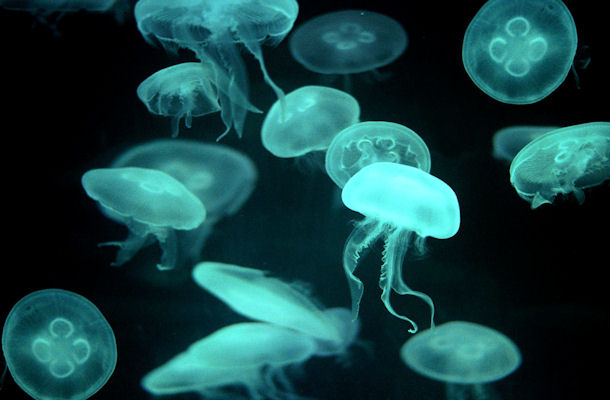
Goal: To evaluate the importance of jellyfish as predators of zooplankton in Prince William Sound.
Prince William Sound, Alaska was the site of an extensive oil spill in March 1989. Many of the vertebrate populations (fishes, birds, mammals) that were seriously damaged by the oil spill have still not recovered.
We examined whether the lack of recovery of zooplanktivorous fishes, such as herring, was due to competition for food with jellyfish, which have large populations in the sound. We determined the feeding rates of jellyfish on zooplankton and compared this with zooplankton standing stocks to estimate if jellyfish predation could have reduced the zooplankton that would otherwise be available to fishes. To see the abstract, click here.
This project received funding from the Exxon Valdez Oil Spill Trustee Council.
Solar Desalination Technology Development
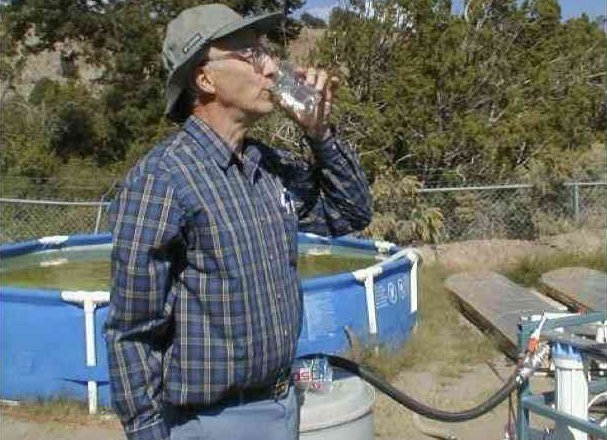
Some 12,500 desalination plants currently supply 1% of the world’s drinking water. Although desalination technologies have been available for decades, the traditionally high costs associated with converting sea water to drinking water have prevented their more widespread adoption. Cost-saving innovations in seawater desalination technology are expected to increase its adoption worldwide.
Los Alamos-based Solar Energy, Ltd. developed a solar desalination unit that filters salt or brackish water into potable water for as little as one-fifth the cost of the least-expensive existing technology. The desalination unit employs a new solar collector technology and off-the-shelf reverse-osmosis filtration.
We advised them on how to get beyond the prototype phases and interest companies and others that might want to work with them to do so. Commercialization may include licensing or selling the technology to major manufacturers, joint ventures with companies or government agencies worldwide, or acquiring sufficient additional investment capital to do it themselves.
Client: Solar Energy, Ltd.
Urban Ecological Entrepreneur Program

Cleveland’s Upper East Side neighborhoods were long overlooked and undervalued by traditional investors. Relative to the rest of the region, the roughly 100,000 residents have a higher poverty rate (42% vs. 12%), lower per capita income ($8,258 vs. $17,128) and greater unemployment (14.8% vs. 4.9%).
The Urban Ecological Entrepreneur program, developed by the Shorebank Enterprise Group, the City of Cleveland, local community development corporations and TerrAqua, is seeking to ensure neighborhood sustainability and long-term viability. They are trying a new, more inclusive approach that encourages greater community involvement in deciding their own fates, and introduces (or re-introduces) some of the environmental and natural resource context in which the neighborhoods were first developed and now exist.
The program is establishing environmentally sound business ventures to benefit the neighborhoods with economic growth (jobs, added commercial revenues, new economic clusters) and greater decision-making capabilities. Program elements include providing environmental information, articulation of neighborhood needs, reclaiming abandoned land, pollution prevention and neighborhood safety.
Goals include (1) helping the community identify and assess environmentally sustainable economic and entrepreneurial opportunities, (2) developing a business plan for at least two of these opportunities, and (3) developing a permanent neighborhood capacity to promote sustainable economic development.
Shorebank Enterprise Group was established in 1994 as part of Shorebank Corporation, a community development bank. Shorebank’s mission is to increase opportunities for residents of underinvested communities, and they have invested over $800 million in urban and rural communities since 1973. Since 1995 Shorebank Enterprise Group and its affiliates have invested $55 million in the Cleveland area, most in the city’s Upper East Side. Shorebank also operates two Enterprise Centers that house 50 businesses and finance 700 housing units.
Shorebank has remediated brownfield sites for commercial and industrial use, and works with the Cuyahoga County Solid Waste Management District to encourage environmentally progressive products.
Client: Shorebank Enterprise Group
TerrAqua’s role: Grant writing and program development.
Staff
Principal
Consultants
Research Assistants
Daniel J. Grosse
(B.S., Natural Resources, University of Michigan; M.S., Ph.D., Fisheries Biology, University of Washington) is co-founder and president of TerrAqua. His recent focus has been aquaculture and agriculture development. He has developed farming studies and projects for clients ranging from small, distressed traditional communities to a Fortune 500 company. These projects often encompass cultural, environmental and economic preservation. Earlier, he advised clients—government agencies, environmental law firms, universities, Fortune 500 companies—on sustainable development issues, and on the fate and transport of environmental contaminants and assessment of ecological and human health risks in marine and aquatic ecosystems. He developed a conference series on marine pollution effects on fisheries and ecosystems, and its significance to environmental managers. He evaluated global climate change, international ocean issues, water quality issues, coastal protection, aquaculture and the fishing industry at the National Marine Fisheries Service and the U.S. Navy. He has worked as a farmer on Israeli agricultural collectives, and currently grows oysters commercially in Chincoteague, Virginia. He is also a senior associate with the Arlington, VA-based Ocean Associates, Inc., a NOAA Fisheries contractor, and an adjunct professor at the University of Maryland University College Graduate Program in Environmental Management, where in 2011-2012 he received the university’s top teaching award.
Anthony D. Battaglia
(B.S., Psychology, Tufts University; MBA, Finance, Columbia University) is a principal of ADB Capital LLC in Tucson, Arizona, an investment vehicle that provides growth-stage funding and mentoring to small businesses, and a Partner with The Partnering Group, a global consultancy providing operational and strategic services to consumer product marketers, retailers and wholesalers. From 1985 until 2000 he held Executive Vice President and President (of Diversified Foods) positions with Chiquita Brands International and became chief architect of the Company’s diversification strategy with full P&L, balance sheet and development responsibilities for the Company’s principal non-banana activities. He started his career at Chiquita as EVP, Worldwide Banana Sales, Marketing, Quality and Technology. Prior to joining Chiquita, Mr. Battaglia held senior management positions with The Direct Marketing Group (the country’s largest independently owned direct-response advertising agency), General Host Corporation (a highly diversified food, agriculture, hospitality and specialty retailing Fortune 500 Company) and Arthur Young and Company.
Gina Beim
(B.S., Civil Engineering, PUC University, Rio de Janeiro, Brazil; M.S. Systems Engineering, M.S., Operations Research, MBA, Case Western Reserve University) is a registered Professional Engineer in the State of Ohio. Ms. Beim spent two decades holding positions of increasing responsibility in the water and wastewater fields, including managing the Westerly Combined Sewer Overflow Facilities Planning project for the Northeast Ohio Regional Sewer District. She then founded MCDA Consulting LLC, which for several years directed the marketing department of firms in the geotechnical engineering world. She has more recently refocused MCDA Consulting onto her original field of water resources engineering and on her lifelong passion for Multi Criteria Decision Analysis (MCDA), a tool that helps organizations prioritize and select among alternatives when complex tradeoffs exist. Ms. Beim is a past president of the Cleveland Section of the American Society of Civil Engineers, chairs the Section’s committee on the Northeast Ohio Infrastructure Report Card, and was honored with the 2017 Cleveland Outstanding Civil Engineer Award.
Robert S. Kallen
(B.A., History and Economics, University of Illinois; M.A., Economics, J.D., Washington University) provides expertise and capital to small and growing companies, especially in the food and agriculture sectors. He is a clinical professor of economics and director of the MS program in economics & policy analysis at DePaul University. He has over 25 years of teaching experience. Kallen was the recipient of the 2007 Daniel Seiden-Adjunct Teaching Award. Mr. Kallen was an adjunct professor at the Lake Forest Graduate School of Management, where he received the 2002 Distinguished Faculty Award and the 2007, 2008, and 2009 Teaching Excellence Award. He has also developed two new courses on business ethics, which concentrate on race, class, and gender issues as well as a course on business, government and democracy, which he is now teaching at Washington University Law School. From 1984-1992, he was vice president of operations and general counsel for Bake-Line Products, Inc (a private-label cookie manufacturing company with national distribution and annual sales of over $100 million). Mr. Kallen was also a staff attorney at the Federal Trade Commission in Washington, D.C. (1982-1984) and at the Environmental Law and Policy Center of the Midwest (1993-1995). He has served on numerous boards and advisory boards in the private sector over the last 20 years. Mr. Kallen is currently the secretary-treasurer of the Concord Coalition Citizens’ Council (a nonprofit organization dedicated to deficit reduction) and treasurer of the Integrated Pest Management Institute. Additionally, he worked on the 1992 Clinton/Gore transition team for economics and was a legislative fellow in 1982 for Senator Paul Tsongas. In 2002, Mr. Kallen was awarded a Rockefeller Next Generation Leadership Fellowship.
Richard C. Karney
(B.S., Biological Sciences, Rutgers University) is Director Emeritus of and a biologist at the Martha’s Vineyard Shellfish Group, Inc. Before that, he worked for the Virginia Institute of Marine Science. For over three decades Mr. Karney has carried out a successful community-based resource development program for the commercially important shellfish species on Martha’s Vineyard. Management efforts have concentrated on the development of hatchery and field aquaculture methods for shellfish and the operation of the Nation’s first public solar shellfish hatchery. In the mid 1990’s, with a $500,000 National Marine Fisheries Service grant, Mr. Karney conducted a shellfish aquaculture retraining program for fishermen displaced by fishing closures on Georges Bank. He is currently helping these fishermen to market their cultured oysters. In 2001, Mr. Karney was awarded the Gulf of Maine Visionary Award by the Gulf of Maine Council on the Marine Environment in part for demonstrating “that shellfish aquaculture can be an environmentally and economically sustainable activity for coastal communities.” Mr. Karney is a past Vice President of the National Shellfisheries Association. He has been co-chair of the Southeast Massachusetts Aquaculture Center since 2001.
Avi Koren
(B.S. Biology, Tel Aviv University; M.S., Plant Physiology, Tel Aviv University) plans, manages and builds desert aquaculture projects for super-intensive production of food and tropical ornamental fishes, prawns and microalgae. He developed integrated aquaculture and agriculture on Israeli Negev Desert farms. Mr. Koren owns and operates a greenhouse at Moshav Paran, in Israel’s Negev Desert, producing premium quality red, yellow and orange bell peppers exported to the U.S. market. He has been a consultant on aquaculture and agriculture development in Southeast Asia, Africa, the U.S. and Latin America. For many years he was a biologist, and later research director, of the Arava R & D Center Aquaculture Research Station, in Ein Yahev, Israel.
Dorothy L. Leonard
(B.S., Political Science, Maxwell School at Syracuse University) is an internationally recognized shellfish aquaculture and restoration expert. She was most recently an environmental analyst for the National Marine Fisheries Service, where she served on the U.S. Department of Commerce Aquaculture Steering Committee. She co-chaired, with the USDA, a Joint Subcommittee on Aquaculture study of aquaculture effluents, and is co-author of EPA’s ‘Nutrient Criteria for Coastal and Marine Waters’. She spent two years as Director of Fisheries in Maryland where she developed an Oyster Restoration Program for Chesapeake Bay and began an oyster culture program for Smith Island watermen. For six years she has co-chaired the International Conference on Shellfish Restoration, and for 15 years served as Program Manager for the ‘National Shellfish Register of Classified Estuarine Waters’. Her background is in coastal management and land use planning.
Barry M. Posin
(A.B., A.M., Chemistry, Harvard University; M.A, Ph.D., Chemistry, Princeton University) is an independent education consultant and veteran educator. He was a professor at Mississippi University for Women, teaching undergraduate courses in organic and inorganic chemistry, and introductory courses in chemistry and physics. He also designed and taught a new course in environmental science. He headed the university’s Science and Mathematics Division for two years, during which time he involved a diversity of stakeholders—students, faculty, staff, outside planners—in the decision-making process on issues ranging from how building renovation affects education to high-profile, politically sensitive hiring decisions. He served on the university’s Honors Committee for several years as well. He was on the chemistry faculty of Montclair State College in the late 1980s and early 1990s. Prior to entering academia, he studied organometallic catalysts and inorganic materials, as a chemist at SRI International, in Menlo Park, CA and, before that, as a postdoctoral fellow at Ben-Gurion University of the Negev. Dr. Posin has also served as a National Science Bowl judge and coordinator.
Jennifer E. Purcell
(B.S., M.S., Biology, Stanford University; Ph.D., Biological Sciences, University of California, Santa Barbara) a Research Associate at Western Washington University, has been a professor of marine science since 1984. Her expertise is in biological oceanography and zooplankton and larval fish ecology. Her specialty is on the ecology of jellyfish. Her activities at various universities over the last three decades have included research in the ocean and estuaries (over 30 research cruises) that was funded by 25 competitive research grants from U.S. funding agencies, teaching (developed and taught 20 graduate and 2 undergraduate classes), advising (official advisor for 23 undergraduate, 7 M.S., 2 Ph.D., and 2 post-doctoral students in U.S. institutions. In addition she worked extensively with 10 Ph.D. students in Ireland, Spain, and Italy. Part of her professional activities includes publishing papers in professional journals (author of over 125 publications), editing (editor of five symposium volumes, associate editor of two major marine journals), reviewing (reviewer for funding agencies and professional journals), and presenting (more than 100 talks at professional meetings universities, schools, and public organizations). She also interviews for media organizations, including radio, television, magazines, and newspapers.
Robert R. Stickney
(B.S., Zoology, University of Nebraska; M.A., Zoology, University of Missouri; Ph.D., Oceanography, Florida State University) is former director of the Texas Sea Grant College Program and is a professor emeritus in the Department of Oceanography at Texas A&M University. Previous academic positions include University of Washington’s School of Fisheries, Texas A&M University’s Department of Wildlife and Fisheries Sciences, Southern Illinois University’s Fisheries Research Laboratory, and the Skidaway Institute of Oceanography. A fellow at the American Institute of Fisheries Research Biologists and Past President of the World Aquaculture Society, he has published well over 100 refereed scientific articles; numerous abstracts, technical and magazine articles; and over 20 books and book chapters, including Principles of Warmwater Aquaculture (1979), Aquaculture in Texas: a Status Report and Development Plan (1981), Estuarine Ecology of the Southeastern United States and Gulf of Mexico (1984), Culture of Salmonid Fishes (1991), Culture of Nonsalmonid Freshwater Fishes (1993), Principles of Aquaculture (1994), Fisheries: Harvesting Life From Water (1995), Aquaculture in the United States: a Historical Survey (1996), and edited the Encyclopedia of Aquaculture (2000). He co-edited Responsible Marine Aquaculture in 2002 and is currently the editor-in-chief of World Aquaculture, the magazine of the World Aquaculture Society, and editor-in-chief of the scientific journal Reviews in Fisheries Science.
Richard M. Strickland
(B.S., Biological Oceanography, University of Michigan, M.S., Biological Oceanography, University of Washington) is an oceanographer at the University of Washington and a freelance scientific writer and editor. He formerly worked as a researcher in the UW school of Fisheries and as a science writer and press officer for the Washington Sea Grant Program. He is the author of books on the oceanography of Puget Sound and the Washington coast, and of technical reports and articles on the potential impacts of climate change on marine fisheries. He worked as writer and editor for the British Columbia-Washington Marine Science Panel, a scientific body appointed to advise the provincial and state governments on pollution problems and research in the Strait of Georgia and Puget Sound. He has also edited numerous scientific documents, including the proceedings of large conferences such as Puget Sound Research ’98 and Fisheries, Habitat, and Pollution ’97.
Richard L. Tysor
(B.A., Economics, Vanderbilt University; M.S. Business and Financial Management, Johns Hopkins University) is Executive Director of Academic Administration at Stetson University. Previously, Mr. Tysor was Executive Director of the Office of Interdisciplinary Program Management for Duke University, Assistant Dean for Business and Finance at the University of North Carolina’s School of Public Health, Assistant Director of the University of Maryland Biotechnology Institute’s Center of Marine Biotechnology, in business management positions at Johns Hopkins University and Hospital, and in major industry and charitable organizations. He has over 20 years of experience in administration, proposal development and grant administration, business operations management and analysis, and strategic planning with academic, military, for profit and not-for profit organizations. He recently consulted on the multi-state Blue Crab Replenishment program for the Chesapeake Bay, and to update the Center of Marine Biotechnology’s recirculating marine aquaculture business/technology plan. Mr. Tysor has worked with TerrAqua since 2003, initially as a client and, after the University of Maryland, as a consultant on aquaculture-related projects.
Geri E. Unger
(B.S., Natural Resources, University of Michigan; M.Sc., Environmental Biology, Hebrew University) is a Cleveland, OH-based consultant to non-profit organizations in conservation, education, and landscape restoration. Earlier, she was the Executive Director of the Society for Conservation Biology based in Washington D.C, where she managed staff, consultants and a budget of $3.2 million per year. Prior to that she served as the Director of Education and Research for the Cleveland Botanical Garden, directing a staff of 14 full time and 130 seasonal staff, as well as raising over $6 million for the Vacant to Vibrant initiative. She has been a consultant to environmental and non-profit organizations in the United States and Israel since 1992. She has initiated programs for public initiatives on air and water quality, energy conservation, biodiversity, ecosystem restoration and land use, pollution prevention, and women’s rights. As an environmental program officer for the George Gund Foundation in Cleveland, she administered local, regional and national grant programs in air and water quality, hazardous and solid waste disposal, and sustainable development. Ms. Unger has taught ecology and environmental studies and conducted research on restoration of vacant urban land, watershed protection, land-use planning and policy, public health protection and aquaculture management in Israel. She is co-founder and past president of TerrAqua.
David Farkas
(B.A. Economics, St. Mary’s College of Maryland, M.S., Economic Policy Analysis, University of Maryland Baltimore County) is Deputy Director and a revenue policy analyst for the Maryland Bureau of Revenue Estimates. He worked as a research technician at the Morgan State University Estuarine Research Center in St. Leonard, MD on an economic feasibility study of small-scale oyster aquaculture for local watermen. He provided budget management of the oyster aquaculture feasibility study and drafted a grant proposal for future aquaculture work. He assisted with projects including shoreline biodiversity sampling, and the Maryland Department of Natural Resource’s 2010 Blue Crab Survey. Mr. Farkas also studied agricultural production and food security in the Gambia, West Africa in 2008.
Christina Pepper
(B.A. International Relations, American University) currently owns and operates Pepper’s Pastries in Lower Faversham, England. Previously, she provided research assistance for several Washington, DC for-profit and non-profit organizations. She worked with TerrAqua on an aquaculture feasibility study for the Town of Southampton, New York. Ms. Pepper has also studied and worked with community development projects in Europe, West Africa and Asia. From 1999 to 2001, as a Peace Corps volunteer in Bukhara, Uzbekistan, she established an independent theatre troupe with the National Puppet Theatre of Bukhara, to expand the tourism industry and facilitate cultural exchange, and taught English. She has also worked for the Washington DC-based Center for Strategic and International Studies.
Kyle Krezdorn
(B.S., Marine Science, Kutztown University) is a Research Technician at the University of Georgia’s Skidaway Institute of Oceanography, where he monitors beach and offshore sediments for the Georgia Sand Gap Analysis Project. Previously he was the Chincoteague Bay Field Station’s University and Research Coordinator, teaching undergraduate students about local flora and fauna. Kyle was also a research assistant on TerrAqua’s “Encouraging Successful Recirculating Aquaculture and Aquaponic Systems” study for the Atlantic States Marine Fisheries Commission.